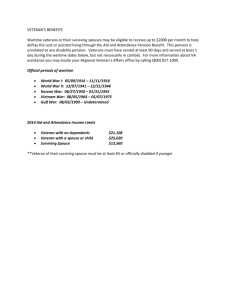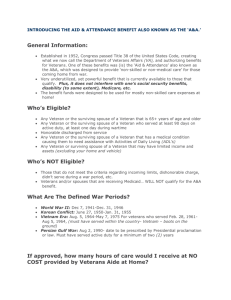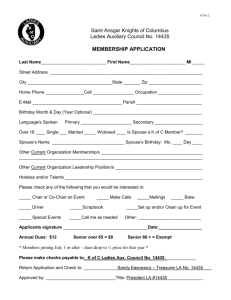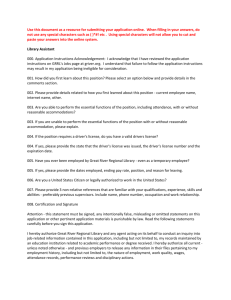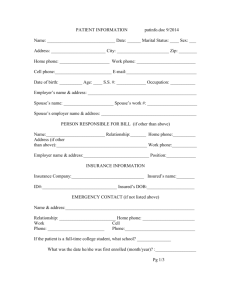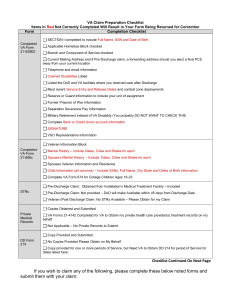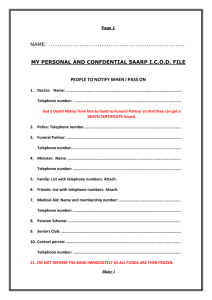Document in word format - Military Officers Association of America
advertisement
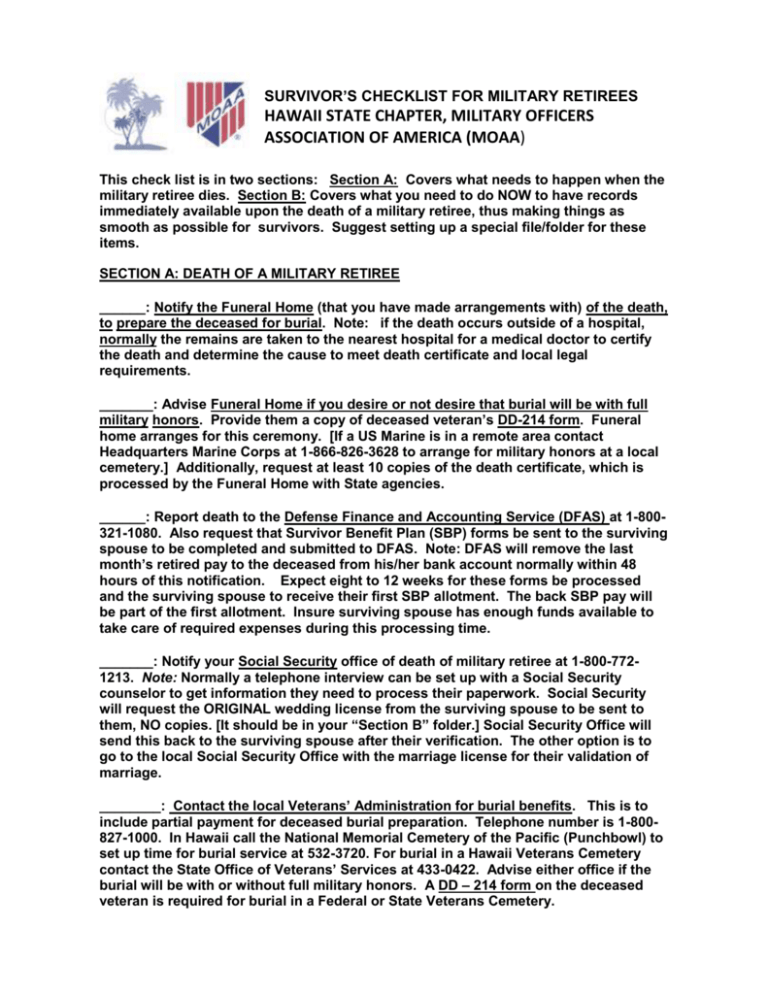
SURVIVOR’S CHECKLIST FOR MILITARY RETIREES HAWAII STATE CHAPTER, MILITARY OFFICERS ASSOCIATION OF AMERICA (MOAA) This check list is in two sections: Section A: Covers what needs to happen when the military retiree dies. Section B: Covers what you need to do NOW to have records immediately available upon the death of a military retiree, thus making things as smooth as possible for survivors. Suggest setting up a special file/folder for these items. SECTION A: DEATH OF A MILITARY RETIREE ______: Notify the Funeral Home (that you have made arrangements with) of the death, to prepare the deceased for burial. Note: if the death occurs outside of a hospital, normally the remains are taken to the nearest hospital for a medical doctor to certify the death and determine the cause to meet death certificate and local legal requirements. _______: Advise Funeral Home if you desire or not desire that burial will be with full military honors. Provide them a copy of deceased veteran’s DD-214 form. Funeral home arranges for this ceremony. [If a US Marine is in a remote area contact Headquarters Marine Corps at 1-866-826-3628 to arrange for military honors at a local cemetery.] Additionally, request at least 10 copies of the death certificate, which is processed by the Funeral Home with State agencies. ______: Report death to the Defense Finance and Accounting Service (DFAS) at 1-800321-1080. Also request that Survivor Benefit Plan (SBP) forms be sent to the surviving spouse to be completed and submitted to DFAS. Note: DFAS will remove the last month’s retired pay to the deceased from his/her bank account normally within 48 hours of this notification. Expect eight to 12 weeks for these forms be processed and the surviving spouse to receive their first SBP allotment. The back SBP pay will be part of the first allotment. Insure surviving spouse has enough funds available to take care of required expenses during this processing time. _______: Notify your Social Security office of death of military retiree at 1-800-7721213. Note: Normally a telephone interview can be set up with a Social Security counselor to get information they need to process their paperwork. Social Security will request the ORIGINAL wedding license from the surviving spouse to be sent to them, NO copies. [It should be in your “Section B” folder.] Social Security Office will send this back to the surviving spouse after their verification. The other option is to go to the local Social Security Office with the marriage license for their validation of marriage. ________: Contact the local Veterans’ Administration for burial benefits. This is to include partial payment for deceased burial preparation. Telephone number is 1-800827-1000. In Hawaii call the National Memorial Cemetery of the Pacific (Punchbowl) to set up time for burial service at 532-3720. For burial in a Hawaii Veterans Cemetery contact the State Office of Veterans’ Services at 433-0422. Advise either office if the burial will be with or without full military honors. A DD – 214 form on the deceased veteran is required for burial in a Federal or State Veterans Cemetery. ________: Notify the deceased military retiree’s current or recent employer, if any, so that pension, medical plan, company savings plan, and insurance can be dealt with properly. _______: Update your surviving spouse military identification card at any military installation. Refer to your MOAA Hawaii Membership Directory for Base phone numbers. _______: If deceased veteran had been receiving Veterans Administration (VA) benefit payments, contact the VA to have a determination made if cause of death was service related. If deemed service related, surviving spouse may be eligible for VA Dependent Indemnity Compensation (DIC). If DIC is awarded this will be offset by SPB payments in the same amount, but DIC is non-taxable. Telephone number is 1-800 827-1000. _______: Notify deceased veteran’s life insurance policy companies of death. Processing of death benefits cannot occur until death certificates have been issued. In Hawaii this can take up to six weeks. Ensure that the current policies are in your folder or immediately available. _______: Notify any local or other locations’ newspapers of death so an obituary can be printed. Funeral home will many times assist in the drafting of an obituary. Honolulu papers usually require that the obituary come from the funeral home. _______: Notify any fraternal or professional organizations of the decease of the veteran so they can publish this information in their periodical to their membership. DFAS notifies the deceased veteran’s military service for inclusion in their “Retired Newsletter” to those service retirees. Your Hawaii MOAA Assistance Officer will notify the MOAA National magazine, “Military Officer”. SECTION B: RECORDS AND ACTIONS TO BE TAKEN PRIOR TO THE DECEASE OF A VETERAN. Set up a file. Make sure that your survivors – spouse, children, and executor – know where it is. Keep it up to date. What to include: _______: The veteran’s DD – 214 form. Have 10 copies of this form in your files. NO earned veteran benefits, to include burial etc. can be received without the agency involved being provided a copy of this form. Know where this form is located if it’s not in your special file. _______: Ensure that a Will for the veteran (and spouse) has been prepared and is up to date. Be specific about your desires for the distribution of assets in the estate. No Will means that your estate ends up in the State Court system, even if there is a surviving spouse. Copies of both Wills should be in a location that is known by the surviving spouse, children of the family, and family attorney, if not in your file. ________: Strongly consider having a Revocable Trust established for the veteran’s (and spouse’s) estate. In Hawaii, the estate will go into probate, even with a valid Will. Without the trust, probate can take up to one year to settle and is expensive. Check local State laws, for they vary widely in this area. _______: Prepare and execute an End of Life Directive (“Living Will”) that clearly states the veteran’s (and spouse’s) preference relative to life support. If this document is not available to the doctor or hospital where the veteran (or his spouse) is being treated and may require life support, these persons/agencies are required to continue a life support program. Make copies! If the patient is discharged, the “Living Will” will be destroyed; you’ll need another for the next hospitalization. If no “Living Will” is available the surviving spouse can normally make the decision to continue or stop the life support process. Include also the veteran’s (or spouse’s) desire for casket burial or cremation. _______: Have a life insurance file readily available with location known by at least two other people (children) other than surviving spouse. Include the veteran’s military medical files and any Veterans’ Administration (VA) benefit award correspondence. ________: Have a financial file readily available with bank accounts, retirement accounts, stocks/bonds, income tax returns, credit card accounts, investments, real property documents, etc. This can include employment information (pension, 401(k) accounts, medical plans). If these are kept in a safety deposit box, insure at least two people other than the spouse (children), know the location and number of the deposit box, as well as where the first key to that safety deposit box is located. Make a list names and addresses of former employers. Insure two persons have the home safe combination. ________: Have a personal file readily available with funeral arrangement preferences, medical records, contact information on children and other close relations, personal property inventory and home insurance policies, and so on. A “letter of instructions” telling what you want done with your possessions – pets, furniture, jewelry, art works, military memorabilia – will be useful. ________: If any of the above financial or other related information/data resides in the veteran’s (or spouse’s) home computer, insure that required passwords and PIN numbers (include security codes for credit cards) are written down or put on a removable computer thumb/flash drive. Either data storage system has to be stored in a secure location, with at least two people (children) other than the surviving spouse knowing this location. December 2009 / JEH MOAA PAC
